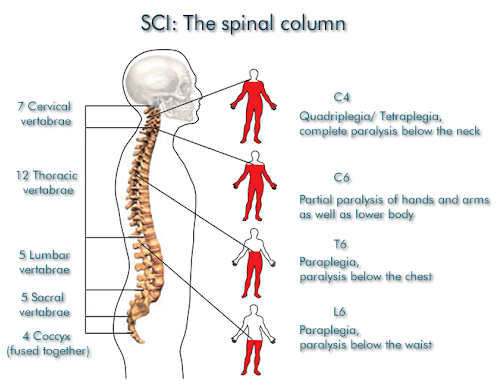Introduction
A spinal cord injury (SCI) is a damage to the spinal cord or nerves at the end of the spinal canal. It is a devastating condition that results in partial or complete loss of motor and sensory function below the level of injury. It can lead to significant physical disability, affecting mobility, independence, and quality of life. While there is currently no cure for SCI, physiotherapy plays a crucial role in rehabilitation, helping individuals regain function, improve strength, and adapt to their new physical condition.
Causes of Spinal Cord Injury
Spinal cord injuries are commonly caused by:
- Trauma – Road accidents, falls, sports injuries, and acts of violence (such as gunshot wounds) can damage the spinal cord.
- Diseases – Conditions like multiple sclerosis, tumors, and infections (such as meningitis) can lead to spinal cord damage.
- Degenerative Disorders – Osteoarthritis, herniated discs, and spinal stenosis can gradually cause spinal cord compression and injury.
Symptoms of Spinal Cord Injury
The symptoms of SCI depend on the severity and location of the injury. Generally, they include:
- Loss of movement – Partial or complete paralysis below the injury level.
- Loss of sensation – Inability to feel touch, temperature, or pain.
- Reflex changes – Increased or decreased reflexes and muscle spasms.
- Bowel and bladder dysfunction – Loss of control over urination and defecation.
- Respiratory issues – Difficulty breathing if the injury is at the cervical level.
- Neuropathic pain – Chronic pain due to nerve damage.
Classification of Spinal Cord Injury
SCIs are classified based on severity:
- Complete SCI – Total loss of function and sensation below the injury level.
- Incomplete SCI – Partial preservation of sensory and/or motor function.

Common Types of Spinal Cord Injuries
- Tetraplegia (Quadriplegia) – Paralysis affecting all four limbs (caused by cervical spine injury).
- Paraplegia – Paralysis affecting the lower limbs and trunk (caused by thoracic, lumbar, or sacral spine injury).
Physiotherapy and Rehabilitation for Spinal Cord Injury
Physiotherapy plays a vital role in maximizing recovery and functional improvement of individuals with SCI. The goals of physiotherapy include restoring movement, preventing complications, and improving the overall quality of life. The rehabilitation process is tailored to the individual’s level of injury and functional goals.
- Early Mobilization and Positioning
- Prevents pressure sores and improves circulation.
- Helps maintain joint mobility and reduces muscle stiffness.
- Range of Motion (ROM) Exercises
- Maintains flexibility and prevents contractures.
- Passive and active-assisted ROM exercises are used based on patient ability.
- Strength Training
- Focuses on strengthening unaffected muscles to compensate for lost function.
- Uses resistance bands, weights, and functional training.
- Gait Training
- Includes parallel bars, weight-supported treadmill training, and robotic-assisted walking.
- Helps patients regain walking ability depending on injury severity.
- Balance and Coordination Training
- Exercises on stability balls, balance boards, and supported standing to improve core control.
- Functional Training and Activities of Daily Living (ADL) Training
- Helps individuals relearn essential tasks such as dressing, eating, and transfers.
- Uses adaptive equipment and task-specific training.
- Neuromuscular Electrical Stimulation (NMES)
- Stimulates weak muscles to enhance movement and strength.
- Useful for individuals with incomplete SCI.
- Pain Management Techniques
- Manual therapy, dry needling, Redcord therapy, and hydrotherapy may be used to reduce pain and muscle spasms.
- Respiratory Physiotherapy
- Breathing exercises and secretion clearance techniques for patients with cervical SCI.
- Helps improve lung function and prevent respiratory complications.
- Assistive Devices and Adaptive Strategies
- Wheelchairs, braces, and orthotic devices help individuals regain mobility.
- Robotic exoskeletons provide support for walking rehabilitation.
- Adaptive tools for daily activities improve independence.
Conclusion
While spinal cord injuries present lifelong challenges, physiotherapy is a cornerstone of rehabilitation, helping patients achieve the highest possible level of function and independence. Advances in technology, such as robotic exoskeletons and FES, continue to expand rehabilitation possibilities. With a personalized and multidisciplinary approach, individuals with SCI can lead fulfilling and active lives.
